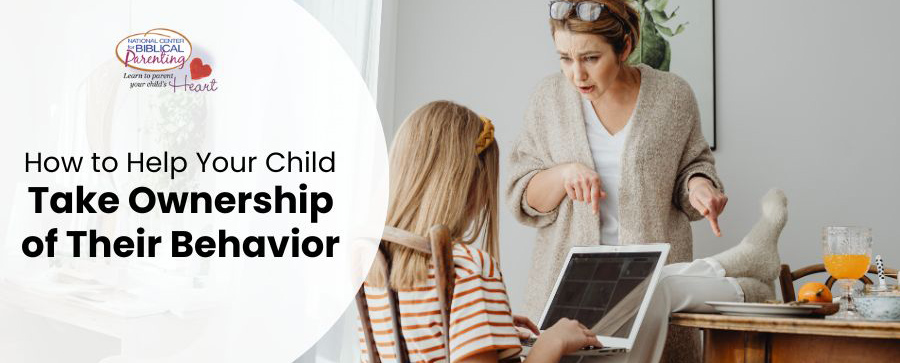How to Help Your Child Take Ownership of Their Behavior

Correction can feel like a tug-of-war. Parents try to rein in misbehavior, and children pull back with excuses, denial, or emotional explosions. But what if there’s a better way—one that doesn’t rely solely on parental control, but instead equips the child to grow in maturity? One of the most powerful, yet often overlooked, parenting tools is learning how to transfer responsibility back to the child. When correction includes this heart-based approach, it shifts the entire dynamic from conflict to growth.
Why Responsibility Must Be Transferred, Not Carried
Many parents shoulder the emotional and practical weight of their children’s problems. They feel responsible for the homework, the attitude, the chores, and even their child’s reaction to being corrected. But that burden is too heavy to carry alone.
Transferring responsibility doesn’t mean abandoning your child or withholding support. It means that as a parent, you’re saying, “This is your problem, and I’m here to help you learn how to solve it.” That shift is empowering. Instead of reacting to correction with defensiveness or blame, children begin to see themselves as participants in the process of change.
Teach Children to Own Their Mistakes
One practical way to transfer responsibility is by expecting your child to report back after receiving an instruction. For example, if you ask your child to clean up their room, you don’t want to keep checking back or nagging. Instead, say something like, “Let me know when it’s done so I can check it with you.” This simple expectation places the burden on the child to follow through, and it reinforces personal ownership.
Another tool is the “Break”—a short time away for a child to settle their heart. Instead of assigning a set time like a punishment, you tell the child, “Take a break until you’re ready to come back and talk calmly.” The child isn’t serving a sentence; they’re practicing self-regulation. And when they return, you can ask key questions like, “What did you do wrong?” and “What would be a better way to handle that next time?” These moments help a child reflect, take ownership, and step back into relationship and responsibility.
Build Maturity One Response at a Time
Children don’t naturally drift toward maturity—they need intentional training. Transferring responsibility is like giving your child a steering wheel and teaching them how to drive their own reactions, decisions, and progress. One powerful example comes from correction conversations. When your child says, “It wasn’t my fault!” or “He made me do it!” it’s tempting to argue or explain. But instead, you can pause and say, “Let’s take a moment. I’m not asking what your brother did. I’m asking what you did.” You’re gently requiring humility and redirecting the focus back where it belongs.
When children begin to see that they’re responsible for their own behavior—not their sibling’s choices or your reactions—they develop an inner compass. They start to grow in self-awareness, repentance, and motivation to change. That’s the real win. Correction is no longer just about compliance—it becomes a launching pad for character development.
Connection Before Correction Still Matters
While transferring responsibility is essential, it can’t stand alone. Children are more likely to accept responsibility when they feel emotionally connected. That’s why building connection before correction remains vital. When a child knows they’re loved—even in the middle of a hard moment—they can be more open to taking responsibility. Harshness or sarcasm shuts down the heart. But grace, combined with firmness, opens the door for honest self-reflection.
You might say, “I love you too much to let this behavior continue,” or “We’re on the same team, and I’m here to help you grow.” These kinds of statements remind children that correction isn’t rejection—it’s discipleship. It’s part of the training process that prepares them for life.
A Heart-Based Approach Changes Everything
If you’re tired of repeating yourself, feeling like the enforcer, or seeing your child resist every form of correction, it might be time to try something different. A heart-based approach doesn’t ignore misbehavior or lower the bar—it raises the standard by focusing on lasting change. Transferring responsibility is one of the key ways to do that. It helps your child move from passive recipient to active participant in their own growth. And it helps you, as the parent, step into your role not just as a rule-enforcer, but as a coach, mentor, and guide.
When you focus on the heart, correction becomes more than discipline—it becomes discipleship. And the fruit of that is long-lasting maturity, not just short-term compliance.
Want More Heart-Based Tools for Correction and Beyond?
Check out the full course How a Heart-Based Approach Changes Everything at app.biblicalparenting.org/it-changes-everything. You’ll discover practical, biblical strategies that help your child grow—and help you feel hopeful and equipped for the parenting journey ahead.



Leave a Reply
Want to join the discussion?Feel free to contribute!